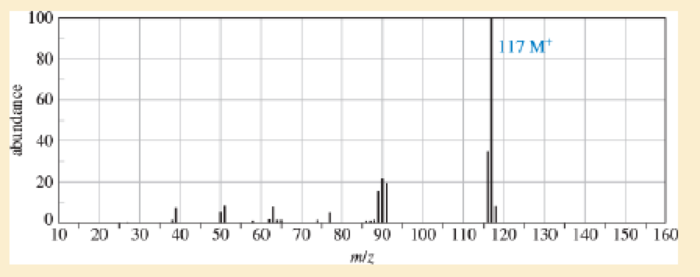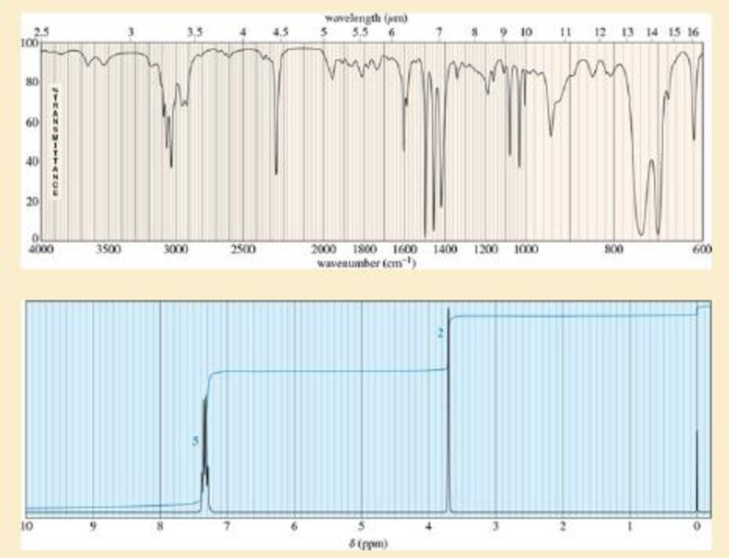
EP ORGANIC CHEMISTRY -MOD.MASTERING 18W
9th Edition
ISBN: 9780136781776
Author: Wade
Publisher: PEARSON CO
expand_more
expand_more
format_list_bulleted
Concept explainers
Textbook Question
Chapter 13, Problem 13.47SP
A compound was isolated as a minor constituent in an extract from garden cress. Its spectra are shown here.
- 1. Look at each spectrum individually, and list the structural characteristics you can determine from that spectrum.
- 2. Look at the set of spectra as a group, and propose a tentative structure.
- 3. Verify that your proposed structure accounts for the major features of each spectrum.


Expert Solution & Answer
Want to see the full answer?
Check out a sample textbook solution
Students have asked these similar questions
Can you help me solve this problem and explain what the answers are?
For which reaction below does the enthalpy change under standard conditions correspond to
a standard enthalpy of formation? (Choose all that applies)
SO2(g) + 1/2 O2(g) → SO3(g)
2H2(g) + C(s) → CH4(g)
Mg(s) + 1/2 O2(g) → MgO(s)
CO(g) + H2O(g) → CO2(g) + H2(g)
CO2(g) + H2(g) → CO(g) + H2O(g)
1/2 H2(g) + 1/2 N2(g) + 3/2 O2(g) → HNO3(g)
CO2(g) + C(s) 2CO(g)
N2(g) + 202(g) → 2NO2(g)
Choose all the molecules with zero standard-enthalpy-of-formation (AH% = 0)
Fe(s)
FeCl2(s)
N2(g)
H2O(l)
02(g)
C(graphite)
K(s)
H2O(g)
Chapter 13 Solutions
EP ORGANIC CHEMISTRY -MOD.MASTERING 18W
Ch. 13.5A - In a 300-MHz spectrometer, the protons in...Ch. 13.5B - Prob. 13.2PCh. 13.6 - Determine the number of different kinds of protons...Ch. 13.6 - Prob. 13.4PCh. 13.7 - Draw the integral trace expected for the NMR...Ch. 13.7 - Prob. 13.6PCh. 13.8C - Draw the NMR spectra you would expect for the...Ch. 13.8D - Draw the NMR spectra you expect for the following...Ch. 13.8D - a. Assign protons to the peaks in the NMR spectrum...Ch. 13.8D - Prob. 13.10P
Ch. 13.8D - Two spectra are shown. Propose a structure that...Ch. 13.9 - Prob. 13.12PCh. 13.9 - The spectrum of trans-hex-2-enoic acid follows. a....Ch. 13.9 - Prob. 13.14PCh. 13.9 - Prob. 13.15PCh. 13.10 - Prob. 13.16PCh. 13.10 - If the imaginary replacement of either of two...Ch. 13.10 - Predict the theoretical number of different NMR...Ch. 13.11B - Prob. 13.19PCh. 13.11B - Prob. 13.20PCh. 13.11B - Prob. 13.21PCh. 13.11B - Prob. 13.22PCh. 13.11B - Prob. 13.23PCh. 13.11B - Prob. 13.24PCh. 13.12E - Draw the expected broadband-decoupled 13 C N M R...Ch. 13.12E - a. Show which carbon atoms correspond with which...Ch. 13.12E - Repeat Problem13-25, sketching the...Ch. 13.12F - Prob. 13.28PCh. 13.13 - A bottle of allyl bromide was found to contain a...Ch. 13.13 - A laboratory student was converting cyclohexanol...Ch. 13.14 - Sets of spectra are given for two compounds. For...Ch. 13 - An unknown compound has the molecular formula C 9...Ch. 13 - Prob. 13.34SPCh. 13 - Predict the approximate chemical shifts of the...Ch. 13 - Prob. 13.36SPCh. 13 - Prob. 13.37SPCh. 13 - Prob. 13.38SPCh. 13 - Prob. 13.39SPCh. 13 - Prob. 13.40SPCh. 13 - For each compound shown below. 1. sketch the 13 C...Ch. 13 - Prob. 13.42SPCh. 13 - Prob. 13.43SPCh. 13 - Prob. 13.44SPCh. 13 - Prob. 13.45SPCh. 13 - Prob. 13.46SPCh. 13 - A compound was isolated as a minor constituent in...Ch. 13 - Prob. 13.48SPCh. 13 - The three isomers of dimethylbenzene are commonly...Ch. 13 - a. Draw all six isomers of formula C 4 H 8...Ch. 13 - Prob. 13.51SPCh. 13 - Hexamethylbenzene undergoes free-radical...Ch. 13 - Each of these four structures has molecular...Ch. 13 - Prob. 13.54SPCh. 13 - Phenyl Grignard reagent adds to 2-methylpropanal...Ch. 13 - Prob. 13.56SP
Knowledge Booster
Learn more about
Need a deep-dive on the concept behind this application? Look no further. Learn more about this topic, chemistry and related others by exploring similar questions and additional content below.Similar questions
- 8.5 g of potassium hydroxide (molar mass = 56.1 g/mol) dissolves in 125 g of water and the temperature of the solution increases by 15.58°C. Calculate the AH soln for potassium hydroxide. Assume the specific heat capacity of the solution is 4.2 J.g¨¹.ºC-1. KOH(s) → →K+ K(aq) + OH AH solution = ?kJ/mol (aq)arrow_forwardWhat will be the final temperature of a 8.79 g piece of iron (CP = 25.09 J/(mol · oC)) initially at 25.0oC, if it is supplied with 302.8 J from a stove?arrow_forwardIdentify the set of stoichiometric coefficients that balances the reaction equation for the combustion of the hydrocarbon below: _ C19 H4002 → CO2 + H2Oarrow_forward
- The cooling system in an automobile holds 11.3 L of ethylene glycol antifreeze. How much energy is absorbed when the temperature of the ethylene glycol goes from 20oC to 100oC? The density and specific heat capacity of ethylene glycol are 1.11 g/mL and 2.42 J/(g ⋅ oC), respectively.arrow_forwardWhich statement about the following chemical reaction is not correct? 2NH3+202 →→→ N2O + 3H₂O ○ It requires 2 mol of ammonia to produce 3 mol of water. It requires 2 mol of dioxygen to produce 1 mol of N2O. ○ Nine moles of water are produced when four moles of ammonia are consumed. Two moles of N2O would be produced when four moles of dioxygen are consumed. Two moles of ammonia react with two moles of dioxygen.arrow_forwardIf 169.7 g of NaOH (40.0 g/mol) were used to prepare 3411.0 mL of solution, what would the concentration be? Group of answer choicesarrow_forward
- The mass of 3.6 mol of some element is 576 g. What is the element?arrow_forwardI have a question about this problem involving mechanisms and drawing curved arrows for acids and bases. I know we need to identify the nucleophile and electrophile, but are there different types of reactions? For instance, what about Grignard reagents and other types that I might not be familiar with? Can you help me with this? I want to identify the names of the mechanisms for problems 1-14, such as Gilman reagents and others. Are they all the same? Also, could you rewrite it so I can better understand? The handwriting is pretty cluttered. Additionally, I need to label the nucleophile and electrophile, but my main concern is whether those reactions differ, like the "Brønsted-Lowry acid-base mechanism, Lewis acid-base mechanism, acid-catalyzed mechanisms, acid-catalyzed reactions, base-catalyzed reactions, nucleophilic substitution mechanisms (SN1 and SN2), elimination reactions (E1 and E2), organometallic mechanisms, and so forth."arrow_forwardI have a question about this problem involving mechanisms and drawing curved arrows for acids and bases. I know we need to identify the nucleophile and electrophile, but are there different types of reactions? For instance, what about Grignard reagents and other types that I might not be familiar with? Can you help me with this? I want to identify the names of the mechanisms for problems 1-14, such as Gilman reagents and others. Are they all the same? Also, could you rewrite it so I can better understand? The handwriting is pretty cluttered. Additionally, I need to label the nucleophile and electrophile, but my main concern is whether those reactions differ, like the "Brønsted-Lowry acid-base mechanism, Lewis acid-base mechanism, acid-catalyzed mechanisms, acid-catalyzed reactions, base-catalyzed reactions, nucleophilic substitution mechanisms (SN1 and SN2), elimination reactions (E1 and E2), organometallic mechanisms, and so forth."arrow_forward
- I have a question about this problem involving mechanisms and drawing curved arrows for acids and bases. I know we need to identify the nucleophile and electrophile, but are there different types of reactions? For instance, what about Grignard reagents and other types that I might not be familiar with? Can you help me with this? I want to identify the names of the mechanisms for problems 1-14, such as Gilman reagents and others. Are they all the same? Also, could you rewrite it so I can better understand? The handwriting is pretty cluttered. Additionally, I need to label the nucleophile and electrophile, but my main concern is whether those reactions differ, like the "Brønsted-Lowry acid-base mechanism, Lewis acid-base mechanism, acid-catalyzed mechanisms, acid-catalyzed reactions, base-catalyzed reactions, nucleophilic substitution mechanisms (SN1 and SN2), elimination reactions (E1 and E2), organometallic mechanisms, and so forth."arrow_forwardShow work with explanation. Don't give Ai generated solutionarrow_forwardShow work. don't give Ai generated solutionarrow_forward
arrow_back_ios
SEE MORE QUESTIONS
arrow_forward_ios
Recommended textbooks for you
 Organic Chemistry: A Guided InquiryChemistryISBN:9780618974122Author:Andrei StraumanisPublisher:Cengage Learning
Organic Chemistry: A Guided InquiryChemistryISBN:9780618974122Author:Andrei StraumanisPublisher:Cengage Learning

Organic Chemistry: A Guided Inquiry
Chemistry
ISBN:9780618974122
Author:Andrei Straumanis
Publisher:Cengage Learning

IR Spectroscopy; Author: Professor Dave Explains;https://www.youtube.com/watch?v=_TmevMf-Zgs;License: Standard YouTube License, CC-BY